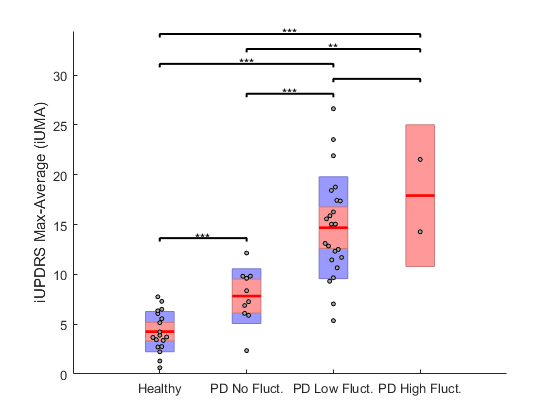Category: Technology
Objective: The objective of this study is to evaluate the efficacy in fluctuations detection of a system consisting of wearable devices embedding Inertial Measurement Units (IMU), designed for Parkinson’s disease (PD) motor symptoms monitoring.
Background: Parkinson’s disease (PD) management and treatment are largely based on scale-based symptom rating but this is a subjective and coarse-grain approach. To complement clinical evaluation, automated, objective methods of PD symptom monitoring, through wearable sensors and smart technologies, gain popularity among healthcare professionals. This study evaluates the efficacy of a novel wearable system in detecting dyskinesia and ON/OFF fluctuations [1].
Method: Sixty-one patients and eighteen healthy individuals were recruited. They wore the system consisting of five wearables (wrists, shanks and waist) for at least 2 hours and patients were assessed by a PD expert using the Unified Parkinson’s Disease Rating Scale (UPDRS) Part III and Abnormal Involuntary Movement Scale (AIMS) at half-hour sessions. An expert physician also examined the sessions and classified the patient ON/OFF fluctuations and dyskinesias in three levels (no, low and high). The system of wearables produced an instrumented UPDRS (iUPDRS) and an instrumented AIMS (iAIMS) score estimation for each patient. The difference between max and average iUPDRS scores (iUMA) was used as a measure of patient ON/OFF fluctuations and iAIMS for dyskinesias. A ROC analysis on those measures was applied to predict expert physician outcome.
Results: For fluctuations [figure1] iUMA differences were significant (p<0.001) for non-fluctuating versus healthy, low-fluctuating and high-fluctuating. For iAMS [figure2] the differences were significant (p<0.001) between no-dyskinesia patients and patients with either low or high dyskinesia. The ROC analysis demonstrated that fluctuations and dyskinesia were detected with accuracy 86% and 98% by iUMS and iAIMS with thresholds 10.66 and 0.46, respectively.
Conclusion: An IMU-based system of wearables can effectively detect fluctuating PD patients and it can accurately discriminate dyskinesia from daily activities.
References: [1] Odin P, Chaudhuri KR, Volkmann J, et al. Viewpoint and practical recommendations from a movement disorder specialist panel on objective measurement in the clinical management of Parkinson’s disease. NPJ Parkinsons Dis. 2018. 4:14.
To cite this abstract in AMA style:
G. Rigas, D. Kakalou, N. Tachos, K. Tsamis, N. Kostikis, A. Marcante, R. Di Mitri, M. Di Pumpo, S. Konitsiotis, D. Fotiadis. Instrumented Detection of Fluctuations with Wearable Devices in Parkinson’s Disease [abstract]. Mov Disord. 2020; 35 (suppl 1). https://www.mdsabstracts.org/abstract/instrumented-detection-of-fluctuations-with-wearable-devices-in-parkinsons-disease/. Accessed December 14, 2025.« Back to MDS Virtual Congress 2020
MDS Abstracts - https://www.mdsabstracts.org/abstract/instrumented-detection-of-fluctuations-with-wearable-devices-in-parkinsons-disease/


